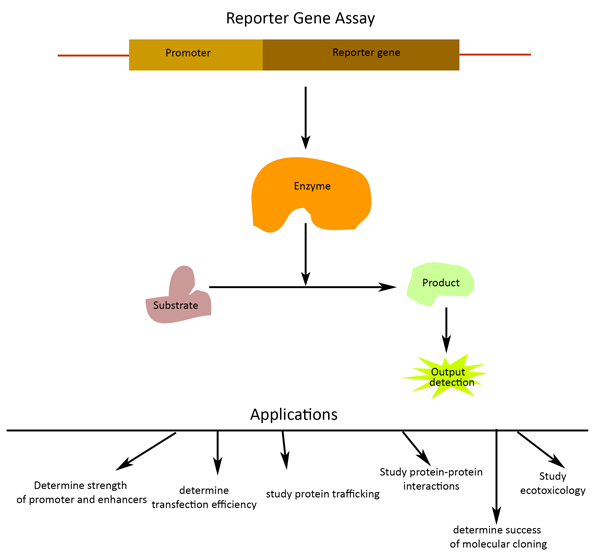Reporter Gene Assays and their applications
Reporter gene assays are paramount for study of regulation of gene expression by gene regulatory elements (cis-acting factors), transcription factors or exogenous regulators (trans-acting factors). In reporter gene assays, the activity of a reporter gene is measured. A reporter gene is joined to a target regulatory DNA sequence in an expression vector, which is then transfected into the cell type of choice. The reporter gene is transcribed and translated in the cells and its activity is measured to access the strength or function of the target regulatory DNA sequence or study effects of transcription factors or potential drugs etc.
Features of a Reporter gene
A reporter gene should be one that encodes for a protein whose activity can be detected with high sensitivity above any endogenous gene activity. An ideal reporter gene is one that does not express endogenously in cells or is expressed at low endogenous level, can be detected with high sensitivity and have a broad dynamic range. Furthermore, the reporter gene assay should be safe, simple, rapid, and relatively inexpensive and should produce reproducible results.
Most commonly used reporter gene that fits the definition, widely available and commonly used are:
- β-galactosidase [β-Galactosidase Assay (CPRG), Fluorescent β-Galactosidase Assay (MUG)]
- β-glucuronidase (GUS assay used mostly for expression in plants)
- Luciferase (Lumino™ Firefly Luciferase Assay)
- Green fluorescent protein (GFP)
- Secreted Placental Alkaline Phosphatase
Furthermore, the choice of reporter assay also depends on the type of study (gene regulation or measuring transfection efficiency), organism and cell type, type of result sought (spatial or temporal), and the preferred detection method (histochemical staining, scintillation counters, spectrometry, fluorimetry or luminometry).
Widespread applications of reporter gene assays
Reporter gene constructs and the reporter gene assays find widespread applications in scientific research:
- Characterize the strength of promoters and enhancers.
To study the strength of promoter or enhancer, the reporter gene is cloned downstream of promoter in a vector and then after transfection, its activity is measured by monitoring expression of the reporter protein. If the expression of reporter gene is high then the promoter is strong and if expression is low then promoter is weak. Similarly, the strength of enhancer region which is upstream of promoter is determined. If the transcription factors when bound to enhancer activate or increase the expression of reporter protein, then the enhancer is strong.
- Help in defining or characterizing role of various transcription factors.
Transcription factors play a key role in signal transduction as they are trans-acting factors which bind to the enhancer region of the DNA upon receiving signal from cell and results in increase or decrease in expression of genes. The effect of transcription factor is multifaceted and its difficult to study its role in cells without using any molecular tool. Reporter genes assay help to alleviate this as one can study effect of transcription factor on desired regulatory sequence or gene expression by cloning the reporter gene downstream of regulatory DNA sequence in a vector and then transfecting vector in cell type or cell line where the target transcription factor is expressed.
- Measures transfection efficiency and the success of molecular cloning.
To measure the transfection efficiency, reporter gene is cloned downstream of a constitutive promoter and then co-transfected along with the experimental plasmid. Expression of reporter protein shows the success of transfection and its quantification is a measure of transfection efficiency. Similarly success of molecular cloning can be monitored by reporter protein expression which is fused with the desired protein.
- Monitoring expression of gene and protein trafficking
Reporter gene fused with gene of interest can help in monitoring expression of the gene and trafficking of the protein as reporter gene can be detected easily.
- Reporter gene assay in ecotoxicology
Reporter gene assays also find application in ecotoxicology for accessing the potential toxic effects of environmental samples. These reporter gene assays are based on tester cells or bioreporters which are genetically engineered to report small toxicity by producing a high quantifiable signal.







